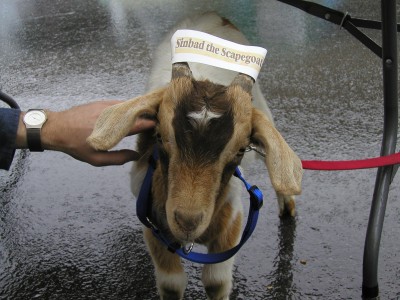
How many sins can a scapegoat hold?Mel Gibson’s hit movie The Passion of the Christ has drawn attention to the doctrine of atonement. This is the idea that a person or group can receive some benefit due to the punishment, suffering or sacrifice of someone else. It is an odd idea that goes against our sense of fairness, but where did it come from? Did the Christians think it up? Interestingly, it is actually a reworking of a very old Jewish idea known as “The Day of Atonement.” This is where a priest would put the sins of the people onto a goat so the people could be free of them.
The scapegoat apparently was a goat that was driven off into the wilderness as part of the ceremonies of Yom Kippur, the Day of Atonement, in Judaism. The rite is described in Leviticus 16. Two male goats were to be brought to the place of sacrifice along with a bull. The high priest then cast lots for the two goats. One goat was offered as a burnt offering, as was the bull. The second goat was the scapegoat. The high priest placed his hands on the head of the goat and confessed the sins of the people of Israel. The goat was then led away into the wilderness, bearing the sins of the people with it, to be claimed by the fallen angel Azazel. These were very superstitious times and perhaps this was a way that people found to comfort their natural feelings of guilt. According to Easton's 1897 Bible Dictionary, the tradition was later modified a little: …the man in whose charge the goat was sent out, while setting him free, was instructed to push the unhappy beast down the slope of the mountain side, which was so steep as to insure the death of the goat, whose bones were broken by the fall. The reason of this barbarous custom was that on one occasion the scapegoat returned to Jerusalem after being set free, which was considered such an evil omen that its recurrence was prevented for the future by the death of the goat. In the movie The Passion, Jesus is shown to suffer incredible torture that goes on and on. People may not realize that at least 20 of the scenes in the movie are fictional and not supported even by the Bible. Many of these scenes were based upon the visions of Catherine Emmerich (1774-1824), a Catholic mystic Mel Gibson considers a saint. Also, scholars have long known that the anonymous Gospel writers were writing several decades after the supposed events and were not eye-witnesses to the events they report (no one knows who wrote the Gospels, the names were guesses made about a century later). But it’s very unlikely that these anonymous Gospel writers would have been around for events such as the questioning before Pilate and Jesus’ conversations on the cross. According to the Bible, Jesus’ most trusted friends all ran away in fear. They weren’t around. But how did Jesus come to be a human scapegoat? Some scholars think that Christians who struggled to make sense of Jesus’ miserable death found comfort by making him out to be a new version of the Jewish “Scapegoat.” The idea of incorporating older scriptures into new stories is a longstanding and common Jewish practice known as midrash, and it is found many times within the Jewish scriptures and the Christian New Testament. When gospel writers sat down several decades after the death of Jesus to put the story of Jesus’ life together, they knew next to no historical details about Jesus. So they scoured the Jewish scriptures looking for what they thought were prophecies and actions that Jesus could be said to perform in order to fulfill supposed prophecies. We know they were doing this because sometimes they misread the scriptures they were trying to have Jesus fulfil. For instance, at Matthew 21:7 the author misread what he thought was a prophecy at Zachariah 9:9. So in his version of the story he has Jesus ask for and receive two donkeys while in Mark, Luke and John’s version of the same story they have him asking for and receiving just one animal. Oops! The Jewish leaders thought their scapegoat could hold all of the sins of Israel, but Christians insist that Jesus can hold all of the sins of the whole world, for all time! That makes Jesus a Super-Duper Scapegoat! But why does anyone have to atone or carry the “sins” of someone else? Why can’t we all just be responsible for our own actions? There are several theories that theologians have came up with to explain how this atonement idea works, but unfortunately, like the idea that a goat can in some way carry away someone’s “sins,” none of them make much sense. The most prevalent atonement theory about why Jesus had to die for your sins is the ransom theory. On this view, because of the fall of Adam, Satan had all of humanity trapped in sin and demanded Jesus as a ransom to pay for the sins. But why would God have to pay anyone a ransom? If God is sovereign, he could just decree that people don’t go to hell for their sins. And that’s the end of it. Does God have to do what Satan demands? Another atonement theory is the satisfaction theory, which is that God’s honor was insulted by sin and he demanded satisfaction. Since we could not satisfy his honor, he had his son die to satisfy his honor. This makes no sense either. Now you know where the idea that Jesus died for your sins came from. It came from the scapegoat. But why would we need Jesus to take away our sins when we have plenty of goats? |
